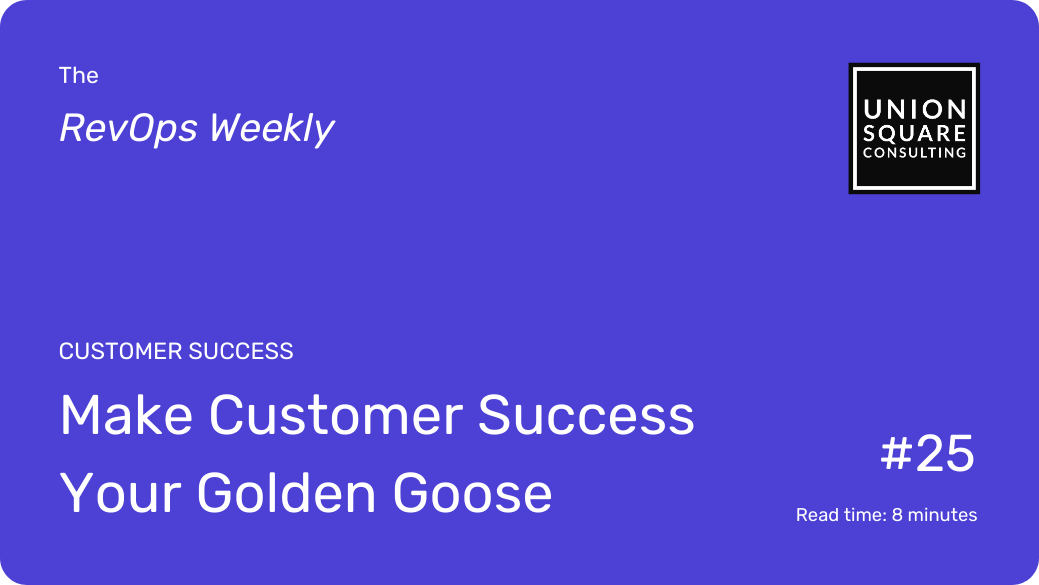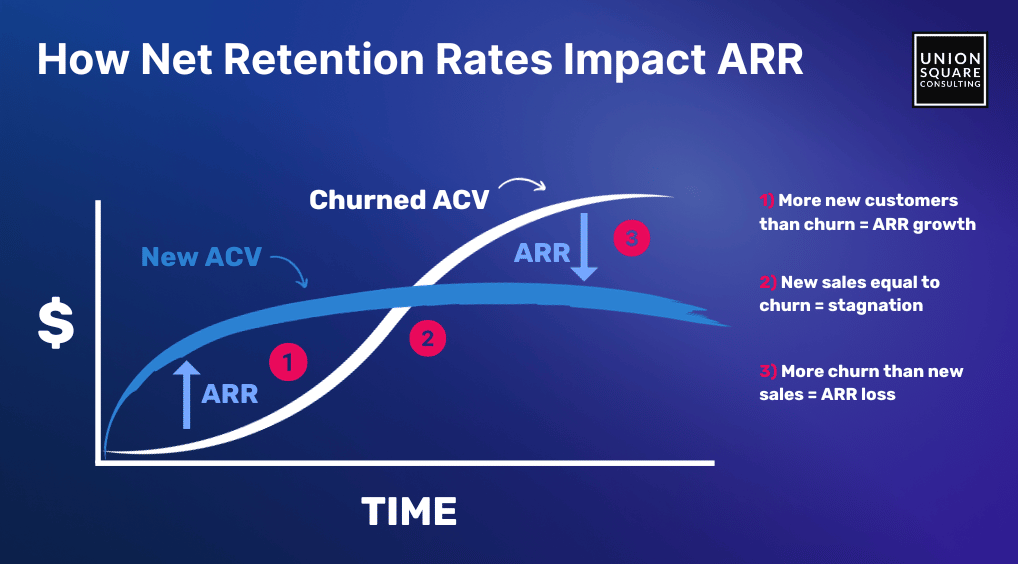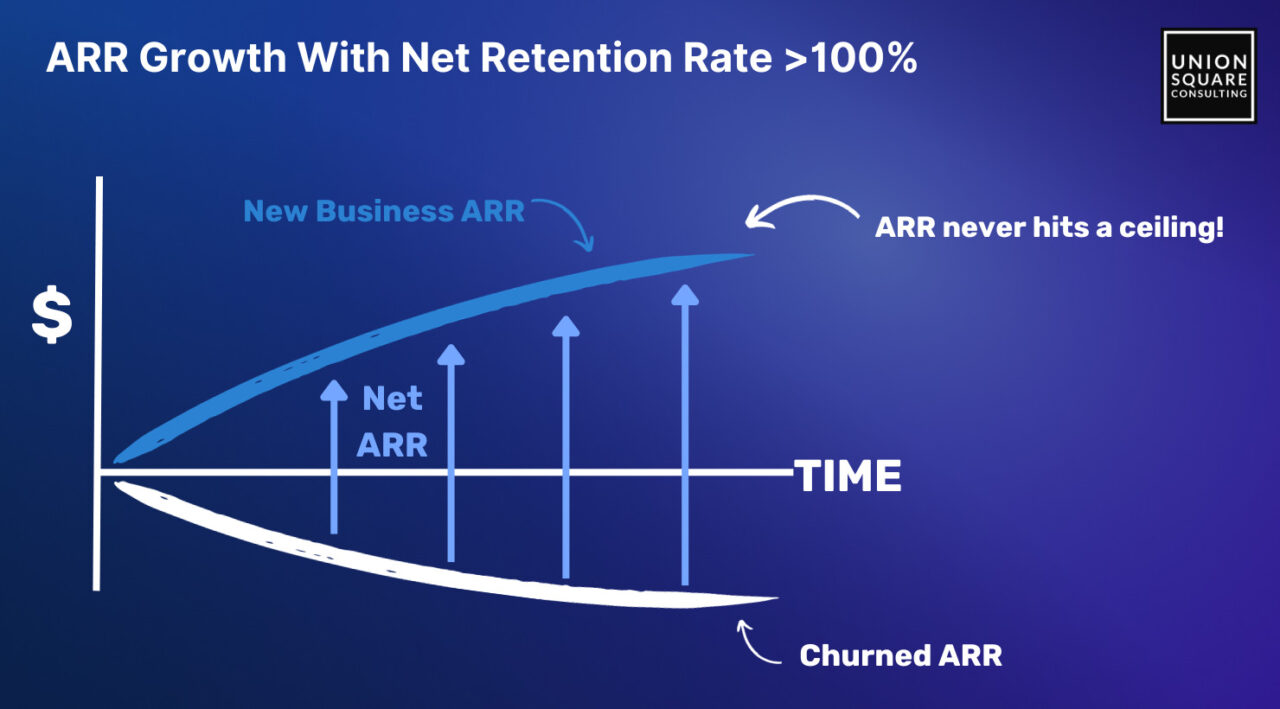
Make Customer Success Your Golden Goose
Read time: 8 minutesToo many companies have:
- No clarity on whether customers will churn or not
- No process on expanding those existing customers
The conversation is always “what’s in the pipeline?”
Yet the max ARR you can make is determined by your retention rates. Recurring customers are the lifeline of your company. That’s the entire point of the SaaS business model.
So why does Customer Success (and therefore retention and expansion) get sidelined?

We get it. The old habit of focusing on new sales and putting customer retention on the back burner used to work.
Funding was easier to come by, no one was monitoring SaaS spend, and renewals rolled over without much thought. Easy peasy. CS just had to focus on onboarding, driving usage, and being a customer advocate.
Now, it’s harder than ever to get funding, which means:
- SaaS spend is highly scrutinized
- New sales are much harder to win
- Existing accounts need more attention to keep
But since it’s also harder for you to get funding:
- Sales gets priority
- Customer Service is understaffed
- Best practices for CS can’t be followed
- You keep pouring water into a leaky bucket
If you’re not maximizing renewal and expansion of existing customers, you’re at serious, serious risk as a business.
And companies who keep treating CS as a cost center instead of a revenue center won’t survive.
So what’s the key to structuring CS?
How can that “key” be a trap that leads to a broken structure anyway?
And what are the other options for companies susceptible to falling in this trap?
The Key To Structuring CS: Capacity Planning
There have always been best practices in place for CS teams to monitor accounts, get ahead of renewals, and identify unhappy customers before they churn.
But as the middle child of organizational departments, Customer Success is often understaffed, underfunded, and underrepresented.
We’ve seen books of 400 customers given to junior CS people. They’re running blind, and they don’t have a choice.
Here’s what happens:
- They might reach out once to all 400 over a year
- Maybe 50 of these customers will respond to them
- They’ll spend all of their time and energy on these 50
- They’ll never end up talking to the other 350 customers
- When it’s those 350 customers that they need a better relationship with
This is the exact opposite of what you want your CS people to be doing: focusing on the healthy accounts, ignoring the unhealthy accounts who are more likely to churn.
The obvious way to solve this is by understanding how many accounts each rep can handle effectively.
This process is called capacity planning – but it’s capacity planning with an eye on “how do we maximize our retention?”
How many people do you need in order to reasonably manage:
- QBRs
- Report backs
- Account planning
- Check-in meetings
- Onboarding implementation
- Identifying at-risk customers
- Identifying customers with upsell potential
Every company, at every stage, needs a sense of the capacity of each headcount in CS.
Unfortunately, this is where things can fall apart.
How Customer Success Becomes Broken
Who owns an already existing customer?
How do you divvy up the responsibilities of making them happy? Making them renew? Making them buy more products?
The assumption is usually that if your customers are happy, they’ll always renew and buy more.
The reality is, CS people are not salespeople (and are rarely hired from a sales background).
So you start to wonder if you’re missing a low-hanging figure by not upselling/expanding as hard as a salesperson would. Maybe sales should be involved?
Then, you do capacity planning for CS and realize how many heads you’ll need for full coverage of all accounts with both a CS person and an account manager or salesperson.
It’s way too expensive.
Here’s where things go wrong:
- You think, “renewals are like sales anyway”
- “Why can’t we have more salesy people in CS roles?”
- You lean more into selling, less into customer advocacy
- Inevitably, customers don’t like being sold to all the time
- They want a CS rep that feels like their buddy and helps them
- Customer metrics start falling off and people start churning even more
The primary function of CS isn’t to upsell and renew. Yes, it’s the end goal, but you can’t run CS like a Sales team. And you can’t expect one person to be both really good at Sales and really good at Customer Success – they are simply opposing cultures.
Having salespeople or account managers run CS is a bad idea.
So what do you do when a hiring spree isn’t in the cards, but you still need your CS people to manage a lot of accounts – and do it successfully?
Alternative Options to Increasing Headcount
If you can’t hire more people, employ other ways to take the burden off of CS.
One way to do this is to restructure your contracts.
Contract structure changes can reduce the effort needed to retain a customer in an environment where you don’t have enough headcount otherwise.
You’ll want to try and remove all clauses that allow customers to easily disappear (as much as your market will allow).
This includes:
- No opt-out clauses
- Long contract terms
- Stringent auto-renew terms
- No terminations for convenience
With this structure in place, renewals become much easier for your CSMs. If your contracts auto-renew, your CSMs only have to worry about opt-outs.
Someone with even menial sales skills can have a light conversation and make a soft close a couple months ahead of renewal time.
Then, ensure your CS team is maniacal about the health of accounts.
- Assess on a regular basis
- Pop up when things are at risk
- Update Sales if they need to intervene
Other ways to unburden your CS team include automation and self service channels.
How to Assess and Improve Account Health
As stated above, your CS team needs to be maniacal about the health of accounts. You do this by measuring product usage and looking for key indicators of customer health.
For example, when I (Eddie) was at Salesforce, we could see what percentage of users logged in once or more in the last two weeks plus the total number of accounts, contacts, leads, opportunities, and activities in their system.
From there we could see who was using it, how they were using it, and maybe even guess why.
If they had a lot of activities but nothing else, then we could assume they were only using the software for marketing emails or sales calls (and we could see the difference as marketing emails are MUCH higher in volume than sales calls).
If they had leads but not opportunities, we could assume the sales team was working out of Excel.
These clues would then inform conversations such as calling the VP of Sales to ask why they weren’t managing their sales pipeline in Salesforce. This often uncovered deeper issues that a CSM could help with.
And when those issues are resolved, the customer benefits from the full potential of the product, making them much less likely to churn.
Bonus Questions
Do you have a renewal pipeline in your CRM?
Do you know exactly how many hours each customer takes through a CSM?
Do you have a playbook for what happens if you identify an at-risk customer?
Likewise, if a customer is happy, do you have a playbook for expanding them?
To be honest, We’ve never seen a company that knew what their CSM capacity was. Rarely do we find places that have their renewals in opportunities in Salesforce, for example.
If you find it hard to answer any of these questions, reach out to us, and we’ll talk about setting you up with a free strategy consulting session.
TL;DR
- For most companies, the biggest source of revenue is recurring customers
- CS is a revenue center, not a cost center
- Most CS teams cannot be effective because there are not enough people and resources to cover all accounts
- To help your CS team increase renewals (and therefore, revenue):
- Do capacity planning
- Hire more people to attain full coverage, if you can
- If you can’t, ease the burden on CS by restructuring your contracts
- Try and remove all clauses that allow customers to easily disappear
- You can also ease the burden with automations and self service channels
When you’re ready, here’s how we can help:
Get a Free 1:1 Revenue Efficiency Workshop
Get one of our Senior Revenue Strategists to yourself for 1 hour and leave with a plan to increase the money-making power of your go-to-market operations.
Hire Us!
Bring us on as your Strategic RevOps Team and realize the growth potential of your revenue engine. There are 3 ways to work with us.
Get more tips like these, sent right to your inbox.
Subscribe for fresh, relevant revenue growth tips delivered every week.